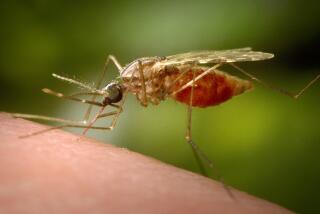Catch As Catch Can
- Share via
Last month one of my medical students stopped me and dropped a bombshell.
“My uncle in India died,” he began.
“Oh?” I answered, expecting news of a heart attack or stroke in middle age.
“He had malaria,” the student continued, looking dazed. “He died 12 hours after arriving at the hospital. I guess I never realized: If he could get it, anyone could.”
In my mind’s eye, I pictured the victim on his last day: His body alternately hot or sopping with sweat, his blood rife with parasites, his brain robbed of oxygen, his stricken body finally yielding to malarial coma and circulatory arrest. In the tropics, such deaths are common, totaling 1 million to 2 million every year.
As a tropical medicine doctor, I’m often surprised how few Westerners grasp malaria’s devastation. That said, its global toll remains staggering. In the last 20 years, it has killed nearly twice as many people as AIDS. Every 30 seconds, it claims another African child. Fifty-year-old corporate engineers are not immune, as my student learned. Malarial mosquitoes can even stow away on international flights--just ask recent unsuspecting victims near airports in Geneva, Paris and Sao Paulo.
Mark Honigsbaum’s “The Fever Trail” chronicles the sweeping back-story of malaria, which, centuries ago, afflicted rich and poor, north and south. The disease also shaped history. In 1741, the fever thwarted England’s seizure of Spain’s New World colonies. In 1809, it trumped the redcoats again when Napoleon deliberately “weaponized” it (by cutting dikes in Holland, he surrounded 40,000 British troops with marshland, an ideal breeding ground for the Anopheles mosquito that transmits malaria). Colonial ambitions in India and Africa often hinged upon malaria. Closer to home, it killed or felled scores of American fighting men in the Civil War, World War II and Vietnam.
Malaria’s costs--human, economic, geopolitical--explain the dogged hunt for antidotes which “The Fever Trail” follows over three centuries. Early on, separating the therapeutic wheat from the chaff wasn’t easy. As Honigsbaum writes, “Quinine had to compete with such well-known and time-tried remedies as viper’s broth, crab’s eyes and spiders, which--imprisoned in rags and hung around the patient’s neck--were thought to act like therapeutic ‘cocoons,’ drawing the ‘poison’ of the fever into their own bodies.”
By the mid-1800s, however, quinine’s merits were unarguable. Pre-DDT and synthetic pharmaceuticals, it was the world’s single hope for malaria. There was just one problem. Cinchona, the source of the life-restoring alkaloid, grew deep in the Andean cloud forest. And so began a high-stakes race among French, English and Dutch explorers to find and steal the elusive tree with the cinnamon bark and the crimson-lined leaves.
Three men eventually led the field: Richard Spruce, a hypochondriac moss collector; Charles Ledger, a cockney fortune-hunter; and Clements Markham, a high-minded geographer. The winner? Technically speaking it was Ledger, whose seedlings later flourished in Dutch-owned plantations on Java. There, and in India, the bark reaped healthy profits for First World investors by saving lives of Third World residents lucky enough to afford it. (Ledger, meanwhile, nearly died in poverty until, at age 79, the Dutch parliament voted him a pension.)
“The Fever Trail” reads like a 19th century thriller set in South America, filled with high adventure and botanical wonder, crisscrossing snowcapped mountains and jungle valleys, the Orinoco, the Rio Negro and the Casiquiare. Honigsbaum, a former reporter for the London Observer who retraced the dizzying footsteps of the original cinchona hunters, deserves praise for meticulous fieldwork and historiography. However, “The Fever Trail’s” most compelling theme is one that echoes ominously today: the tensions among public health, governments and commerce. During the 19th century race for quinine, a few outspoken humanitarians argued for universal access to malaria treatment. Sadly, medical capitalism argued louder. Today, our armamentarium greatly expanded, doctors, governments and multinational business are still caught in the same quandary. Is there light on the horizon? Perhaps. U.N. Secretary-General Kofi Annan’s projected $8-billion global fund for HIV, malaria and tuberculosis is one bright spot.
But ethical dilemmas persist. In particular, Big Pharma, as the international drug industry is known in health circles, still lacks incentives to develop new treatments for tropical diseases whose victims can scarcely pay for a day’s food, much less expensive medications. Witness the pipeline over the last several decades for anti-malarials, a bare trickle in comparison to, say, blood pressure pills for Western consumers. The one notable newcomer on the malaria front is artemisinin, a plant-derived fever remedy first used more than 2,000 years ago in China. It is spectacularly effective against falciparum malaria, the variety that causes 95% of malaria deaths worldwide. That’s the good news.
The bad news? Just like quinine years ago, artemisinin (also known as qinghaosu) is now tangled in its own politics. First world drug companies have been slow to invest in it, and key global agencies--concerned about its cost and quality control--have been slow to endorse artemisinin compounds in official treatment cocktails. If unregulated use continues much longer, the ancient Asian cure will almost certainly lose efficacy, given malaria’s predilection for resistance.
Honigsbaum, I sensed, would have liked to end “The Fever Trail” on a note of hope: the long-awaited malaria vaccine. But after ushering readers on a journey from an experimental primate colony on an Amazon island to the U.S. Navy Medical Research Lab in Bethesda, he cedes to common wisdom: There’s been progress in vaccine research, but a successful jab is still years off.
Meanwhile, some of my hope lies in the next generation. Take my student. Before his uncle died, he was merely considering a career in tropical medicine. Now that malaria’s chill breath has touched one of his own, he’s sure.
More to Read
Sign up for Essential California
The most important California stories and recommendations in your inbox every morning.
You may occasionally receive promotional content from the Los Angeles Times.













